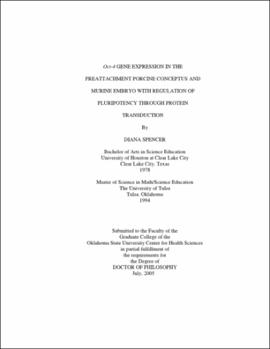| dc.contributor.advisor | Rickords, Lee | |
| dc.contributor.author | Spencer, Diana | |
| dc.date.accessioned | 2013-11-26T08:22:59Z | |
| dc.date.available | 2013-11-26T08:22:59Z | |
| dc.date.issued | 2005-07 | |
| dc.identifier.uri | https://hdl.handle.net/11244/6677 | |
| dc.description.abstract | Scope and Method of Study: To investigate the presence of the Oct-4 transcript in the murine embryo and the preattachment porcine conceptus over time, we quantified the expression of Oct-4, a candidate master regulator gene for the maintenance of pluripotent cells. We also examined the cloning and subsequent protein purification of positive and negative regulators of the Oct-4 gene with the potential for protein transduction therapy. Our first objective was to test the hypothesis that porcine trophoblastic elongation and placental differentiation is associated with the Oct-4 gene expression. Porcine embryos were collected following days 10 to 17 of development. The quantitative analysis used a Real Time, one-step RT-PCR amplification. Our second objective was to test the hypothesis that individual murine embryos exhibit an up-regulation of Oct-4 in the 4-cell, 8-cell, and blastocyst whole embryos and that the individual pluripotent cells would exhibit an increase in single cell expression. RNA of individual murine embryos was reverse transcribed and Real Time PCR performed. Our final objective was to produce an Oct-4 gene enhancer TAT fusion protein, an Oct-4 gene repressor TAT fusion protein and an Oct-4 TAT fusion protein to be used in subsequent studies. We used site-directed PCR mutagenesis to clone the Bmp8b, GCNF and Oct-4 genes in prokaryote expression vectors. Through protein expression in E. coli and FPLC purification, fusion proteins were verified and tested on living cells. | |
| dc.description.abstract | Findings and Conclusions: Using the comparative CT method, the porcine Oct-4 expression was greatest on days 10 and 12 of pregnancy and was approximately 2, 8, and 11-fold greater compared to expression on days 13, 15 and 17, respectively. The down regulation of Oct-4 gene expression between days 12 and 17 is temporally associated with porcine extended trophoblastic elongation and placental differentiation. The murine blastocysts and 8-cell embryos produced 85-fold and 7-fold more Oct-4, respectively, than the four cell embryos. A significant up-regulation of the Oct-4 transcript per totipotent blastocyst cell was demonstrated. The three fusion proteins were produced and verified. The protein transduction initial trials on living cells were unsuccessful in consistently regulating transcription. | |
| dc.format | application/pdf | |
| dc.language | en_US | |
| dc.rights | Copyright is held by the author who has granted the Oklahoma State University Library the non-exclusive right to share this material in its institutional repository. Contact Digital Library Services at lib-dls@okstate.edu or 405-744-9161 for the permission policy on the use, reproduction or distribution of this material. | |
| dc.title | Oct-4 gene expression in the preattachment porcine conceptus and murine embryo with regulation of pluripotency through protein transduction | |
| dc.contributor.committeeMember | Blewett, Earl | |
| dc.contributor.committeeMember | Jarolim, Kirby | |
| dc.contributor.committeeMember | Geisert, Rodney | |
| osu.filename | Spencer_okstate_0664D_1417.pdf | |
| osu.accesstype | Open Access | |
| dc.type.genre | Dissertation | |
| dc.type.material | Text | |
| dc.subject.keywords | oct-4 | |
| dc.subject.keywords | pluripotency | |
| dc.subject.keywords | protein transduction | |
| dc.subject.keywords | murine | |
| dc.subject.keywords | porcine | |
| thesis.degree.discipline | Biomedical Sciences | |
| thesis.degree.grantor | Oklahoma State University | |
